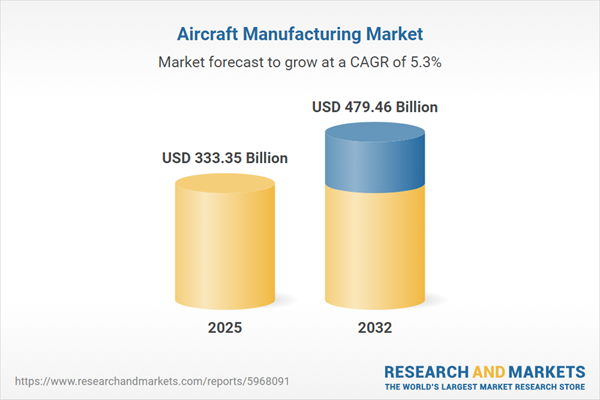Speak directly to the analyst to clarify any post sales queries you may have.
The aircraft manufacturing market is at a pivotal moment, with evolving technologies, regulatory shifts, and global supply chain dynamics rapidly reshaping traditional industry approaches. Industry leaders navigating this space must align innovation with operational efficiency and regulation to position their organizations for future growth and long-term resilience.
Market Snapshot: Strong Growth Across a Dynamic Landscape
The aircraft manufacturing market grew from USD 316.08 billion in 2024 to USD 333.35 billion in 2025. Projected to sustain a CAGR of 5.34%, the sector is expected to reach USD 479.46 billion by 2032, signaling healthy expansion and evolving demand. This upward trend is driven by a continual balancing act between technological advances, regulatory mandates, and operational complexity in both commercial and defense sectors.
Scope & Segmentation: Comprehensive Coverage by End Use, Type, Components, and Propulsion
This report provides a granular breakdown across the full aircraft manufacturing market:
- End Uses: Business Aviation (large cabin jets, light jets, midsize jets, turboprops); Commercial Aviation (cargo carriers, passenger carriers); Defense (combat, trainer, transport aircraft, unmanned aerial vehicles); General Aviation (experimental platforms, helicopters, piston engine aircraft).
- Aircraft Types: Business jets (large, midsize, light); Commercial jets (narrow body, regional, wide body); Helicopters; Military aircraft (fighters, helicopters, trainers, transport); Unmanned aerial vehicles (fixed wing, rotary wing).
- Components: Airframes; Avionics (communication, flight control, navigation systems); Engines (jet, piston, turboprop); Interiors (galley, lavatory, seating); Landing gear.
- Propulsion Technologies: Electric propulsion (battery, hybrid electric); Piston engines (reciprocating, rotary); Turbine engines (turbofan, turbojet, turboshaft).
- Regions: Americas (United States, Canada, Mexico, Brazil, Argentina, Chile, Colombia, Peru); Europe, Middle East & Africa (including United Kingdom, Germany, France, Russia, Italy, Spain, Netherlands, Sweden, Poland, Switzerland, United Arab Emirates, Saudi Arabia, Qatar, Turkey, Israel, South Africa, Nigeria, Egypt, Kenya); Asia-Pacific (China, India, Japan, Australia, South Korea, Indonesia, Thailand, Malaysia, Singapore, Taiwan).
- Companies Profiled: Airbus SE, The Boeing Company, Lockheed Martin Corporation, Northrop Grumman Corporation, Leonardo S.p.A., Bombardier Inc., Embraer S.A., Textron Inc., Dassault Aviation SA, Commercial Aircraft Corporation of China, Ltd.
Key Takeaways for Strategic Decision-Making
- Technological innovation is reconfiguring production—from additive manufacturing and composite materials to growing adoption of digital twins, which enable real-time oversight and agility.
- Emergent propulsion solutions, such as electric and hybrid systems, are transitioning from R&D to development programs. This shift is reinforced by environmental regulations and the prioritization of emission reduction strategies.
- Supply chain resilience is front of mind, as OEMs and suppliers adapt sourcing strategies and embrace digital analytics to manage disruptions and efficiently allocate inventory.
- Strategic partnerships, especially between legacy manufacturers and technology innovators, are accelerating the pace of product development and enabling companies to diversify their offerings.
- Regional growth dynamics contrast sharply: Americas and Europe leverage mature ecosystems and defense investments, while Asia-Pacific pursues rapid fleet expansion and technology transfers to strengthen domestic manufacturing.
Tariff Impact: Navigating Complex Trade Environments
Recent United States tariff changes on raw materials and components have triggered widespread shifts throughout the aircraft manufacturing supply chain. Companies are qualifying alternatives in new jurisdictions, negotiating contractual protections, and developing dual-sourcing frameworks to maintain operational continuity and cost control. These developments reinforce the need for resilient procurement strategies and ongoing risk assessments as trade policies evolve.
Methodology & Data Sources
This research is grounded in a multi-method approach. It blends qualitative insights from primary interviews with senior executives, engineers, and procurement specialists, with robust secondary research, including technical white papers, regulatory agency publications, and patent analyses. Quantitative findings are underpinned by systematic data triangulation and expert reviews, ensuring actionable and reliable intelligence.
Why This Report Matters
- Delivers a strategic foundation for navigating market uncertainty and futureproofing investment decisions in aircraft manufacturing.
- Empowers senior leaders with segment-by-segment intelligence to identify growth opportunities and shape innovation priorities.
- Equips executives with regionally relevant insights and comprehensive coverage of technology trends, helping inform resilient sourcing and partnership strategies.
Conclusion
Aircraft manufacturing continues to evolve amid new operational realities and emerging technologies. This report provides clarity on trends, segmentation, and strategies—enabling industry decision-makers to stay ahead in a competitive global landscape.
Additional Product Information:
- Purchase of this report includes 1 year online access with quarterly updates.
- This report can be updated on request. Please contact our Customer Experience team using the Ask a Question widget on our website.
Table of Contents
3. Executive Summary
4. Market Overview
7. Cumulative Impact of Artificial Intelligence 2025
Companies Mentioned
The companies profiled in this Aircraft Manufacturing market report include:- Airbus SE
- The Boeing Company
- Lockheed Martin Corporation
- Northrop Grumman Corporation
- Leonardo S.p.A.
- Bombardier Inc.
- Embraer S.A.
- Textron Inc.
- Dassault Aviation SA
- Commercial Aircraft Corporation of China, Ltd.
Table Information
| Report Attribute | Details |
|---|---|
| No. of Pages | 184 |
| Published | November 2025 |
| Forecast Period | 2025 - 2032 |
| Estimated Market Value ( USD | $ 333.35 Billion |
| Forecasted Market Value ( USD | $ 479.46 Billion |
| Compound Annual Growth Rate | 5.3% |
| Regions Covered | Global |
| No. of Companies Mentioned | 11 |









